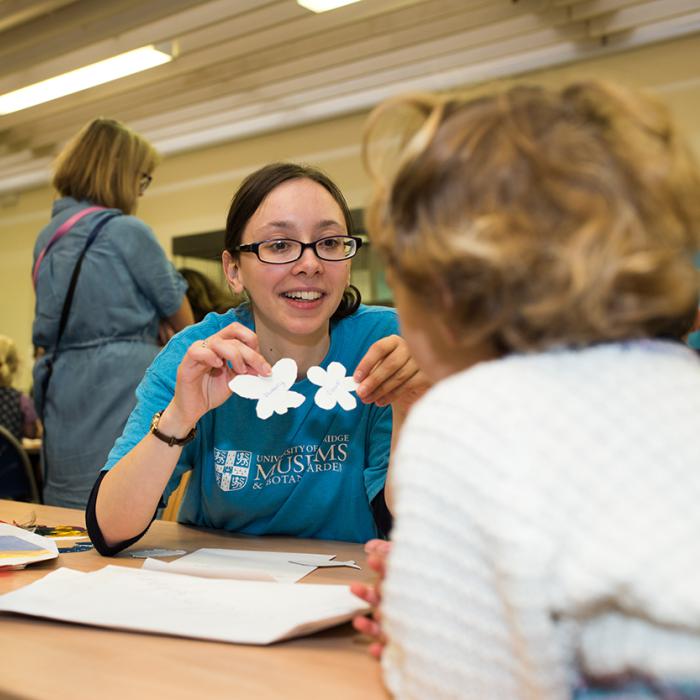Join artist Kaitlin Ferguson in the Clore Learning Studio for a free, interactive workshop all about how art and technology work together.
Using iPads to make drawings inspired by the natural world, you will explore how technology can help us look creatively at the world around us. Kaitlin will also introduce you to her 3D printer, and the materials she uses to print with – including coffee beans!
You will learn new art techniques and skills and explore new ways of creative thinking in a safe and supported space.
This workshop is open to all children aged 8-12.
Join artist Kaitlin Ferguson in the Clore Learning Studio for a free, interactive workshop about the relationship between art, technology, and waste.
Kaitlin will introduce you to her 3D printer and the waste materials she uses to print with, including tea leaves and coffee beans. These activities will contribute to informal discussion about how we can care for the planet and each other.
You will learn new art techniques and skills and explore new ways of creative thinking in a safe and supported space.
Welcome to BioBlitz 2022! Join us at the Cambridge University Botanic Garden as we explore the wildlife at the Garden, with a range of bookable activities for the whole family. We'll be mini beast hunting, pond dipping, running crafty caterpillar workshops, and much much more!
In her 1925 review of Lady Mursaki’s 11th Century novel Tale of Genji, Virginia Woolf admires the technique adopted to draw a clear vision of the male hero: he is conveyed through a method that decenters him and celebrates female intersubjectivity, ‘through the medium of other women’s minds’. Her encounter with the book clearly struck a chord, as a few years later, in an essay about women and fiction, Woolf returns to the Tale of Genji as a vital moment in the history of women’s creativity.
Join us for our new wellbeing and making workshops for adults at the Polar Museum! Meet and Make at the Museum sessions are all about giving you a supportive and social space to be creative. Making new crafts, making space for yourself, and making new connections. A chance for you to explore working with different materials and learn new skills with others. This month, Polar Maps!
For ages 16+
Tuesday 30 August: Where in the World
Join us over Zoom as Matt Hayes talks about the Butterflies Through Time project.
Over the last two years the Butterflies Through Time Project has aimed to engage people with the natural world and environmental change, both past and present, by linking historical museum collections with contemporary conservation initiatives. Join Matt Hayes as he gives an overview of the project; from museum specimens and modern wildlife conservation, to public engagement events and adapting to a global pandemic.
Join us for our new wellbeing and making workshops for adults at the Polar Museum! Meet and Make at the Museum sessions are all about giving you a supportive and social space to be creative. Making new crafts, making space for yourself, and making new connections. A chance for you to explore working with different materials and learn new skills with others.
For ages 16+
Monday 23 May: Auroras
Join us for our new wellbeing and making workshops at the Polar Museum! Meet and Make at the Museum sessions are all about giving you a supportive and social space to be creative. Making new crafts, making space for yourself, and making new connections. A chance for you to explore working with different materials and learn new skills with others.
Monday 25 April, 1pm – 3.30pm Polar Animals
Explore Polar animals with the art of Decoupage
Monday 23 May, 1pm – 3.30pm Auroras
Cambridge has a wealth of sources for those interested in the History of Science. Find out about the science archives and special collections across Cambridge, and how to access them. Discover more about the records that scientists leave behind, what they tell us about their work and life, and how they can be used for historical research.
Drop in to the event anytime over the day.
Access to the event is under the Sedgwick Museum main entrance
Cambridge has a wealth of sources for those interested in the History of Science. Find out about the science archives and special collections across Cambridge, and how to access them. Discover more about the records that scientists leave behind, what they tell us about their work and life, and how they can be used for historical research.
Drop in to the event anytime over the day.
Access to the event is under the Sedgwick Museum main entrance

